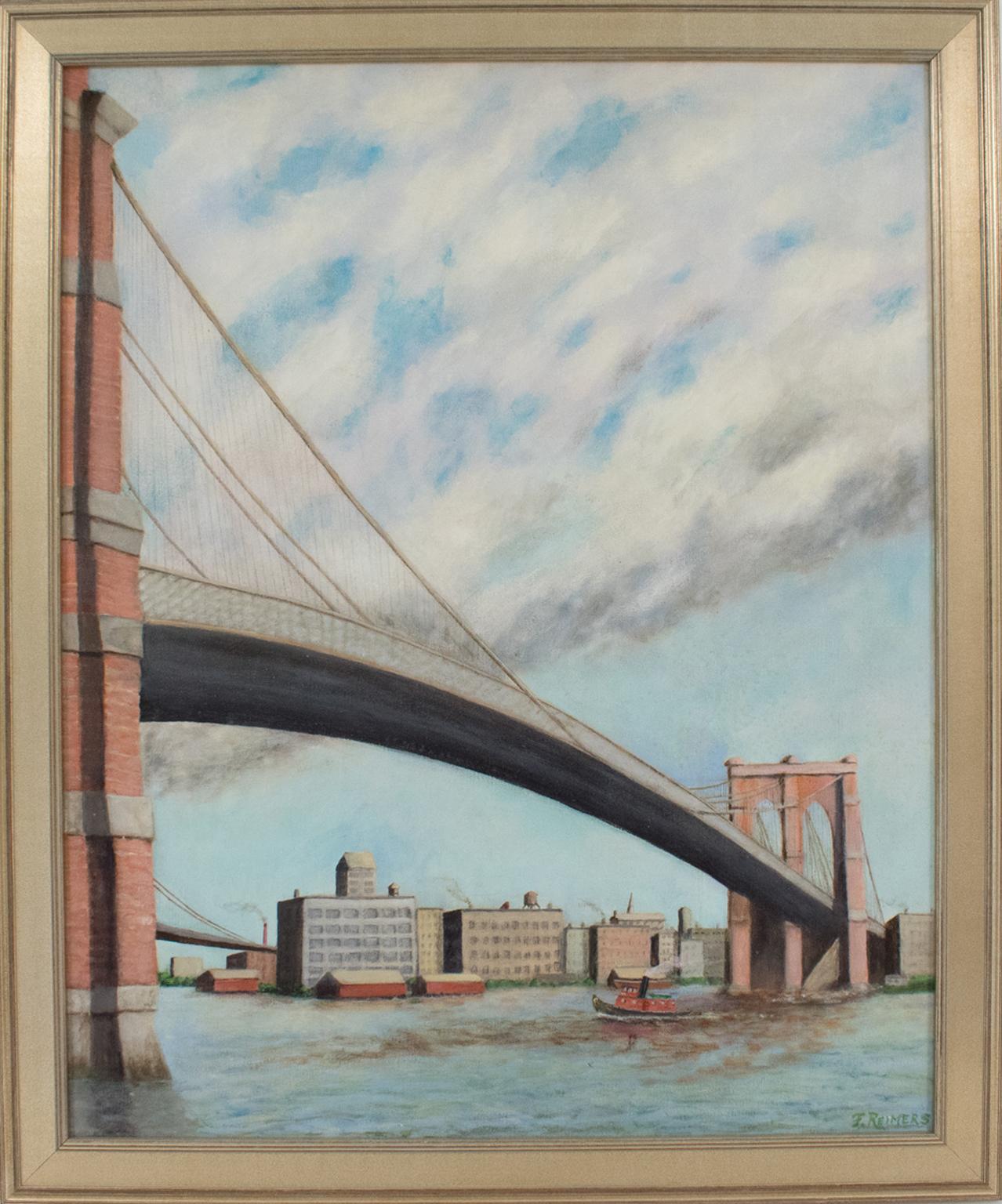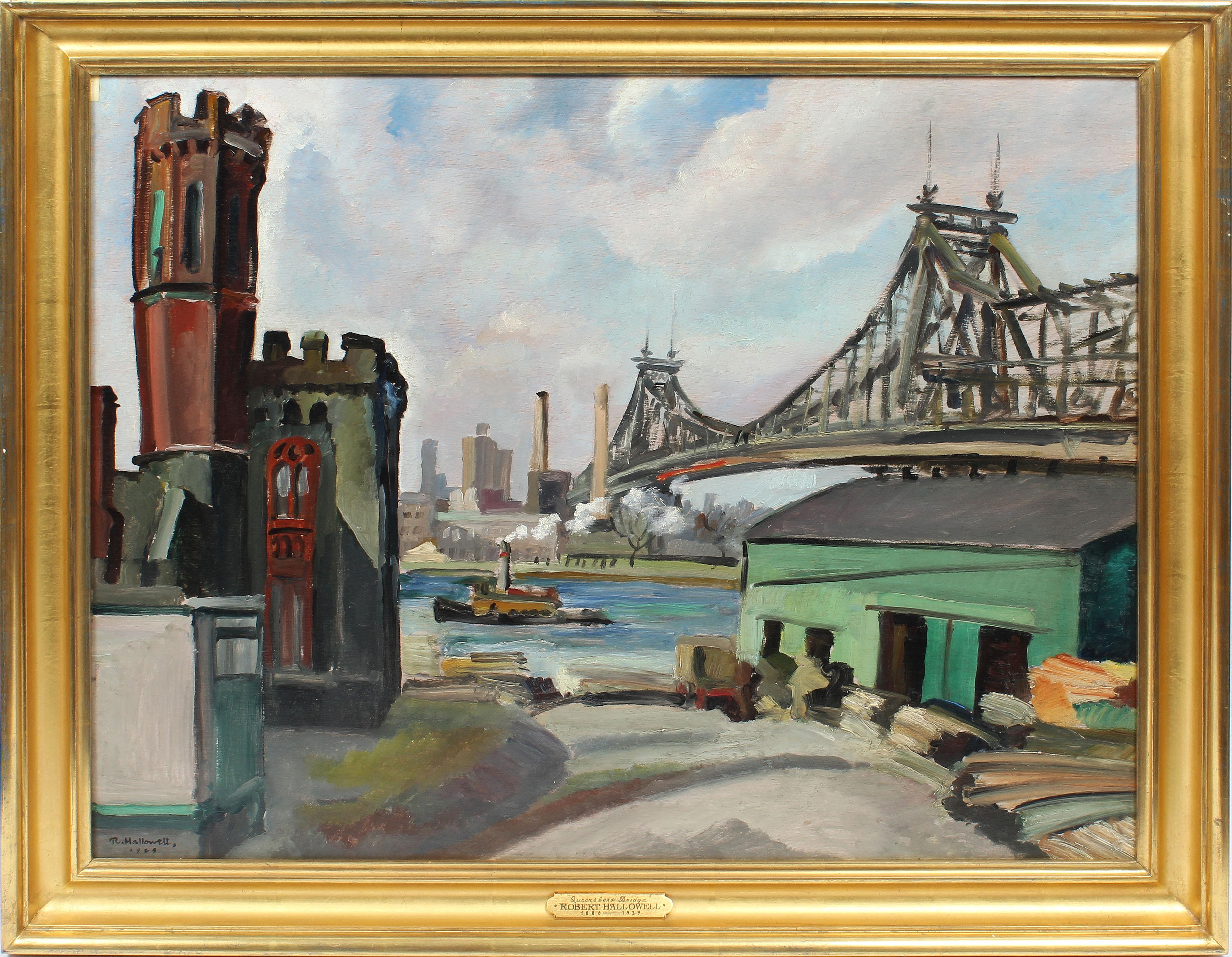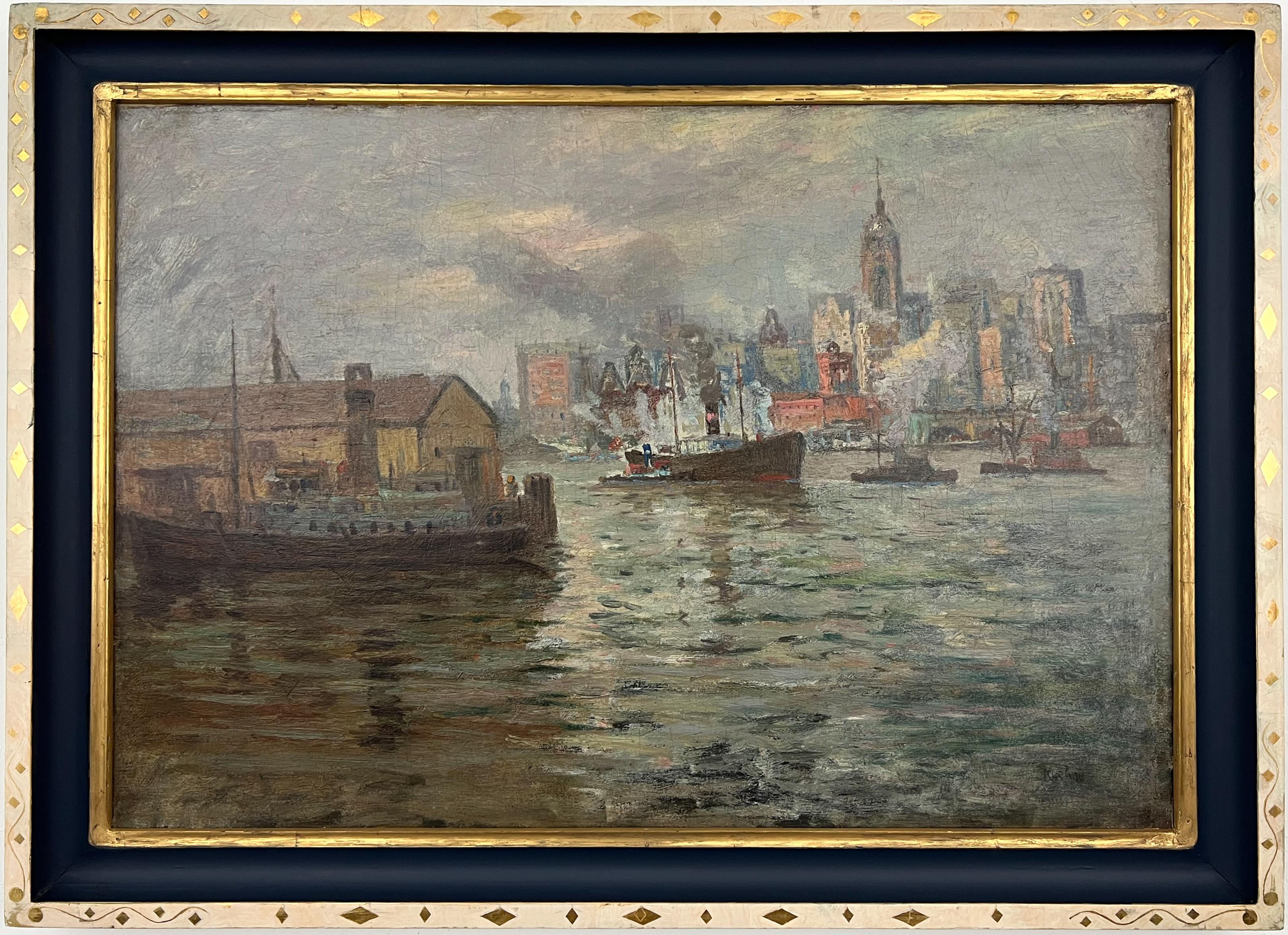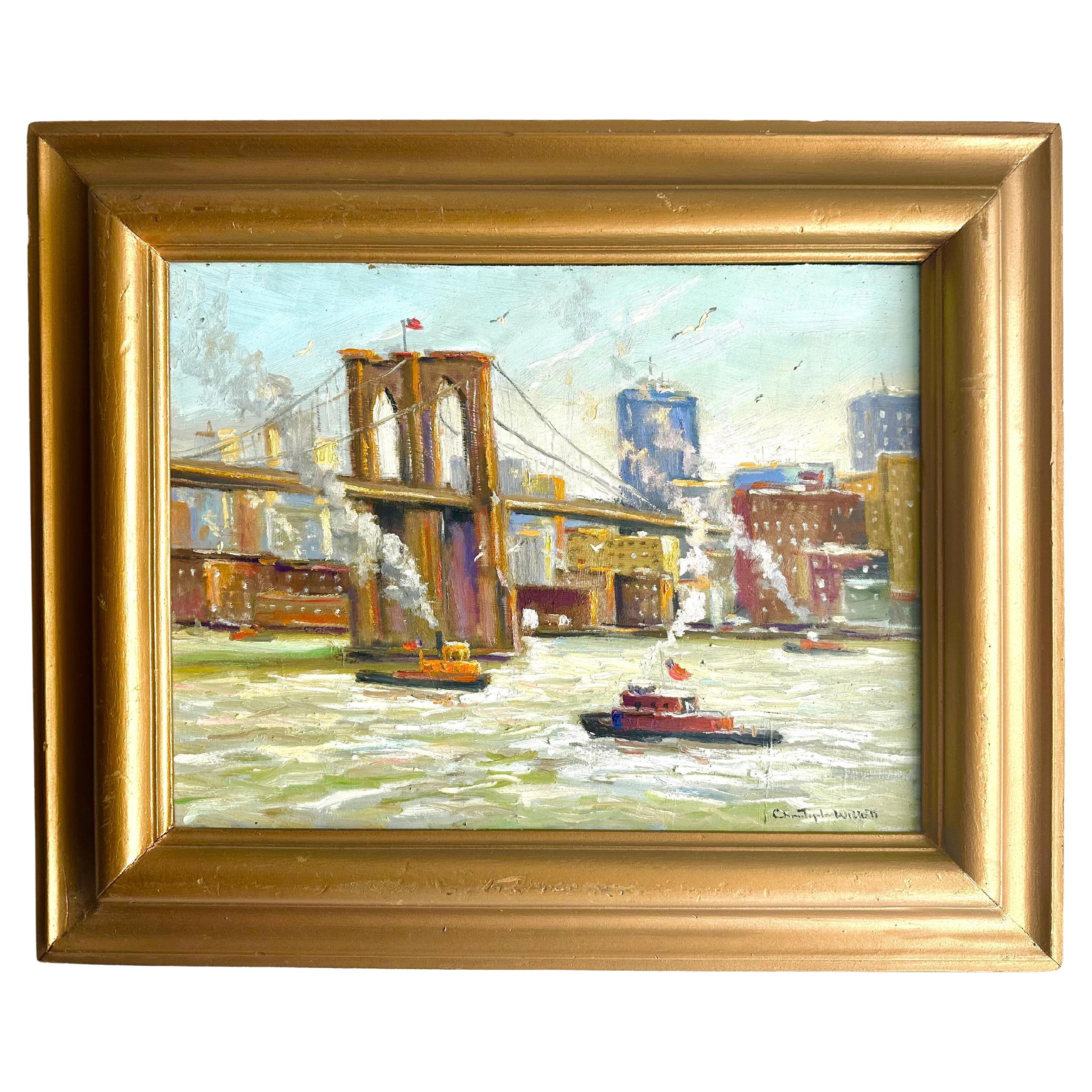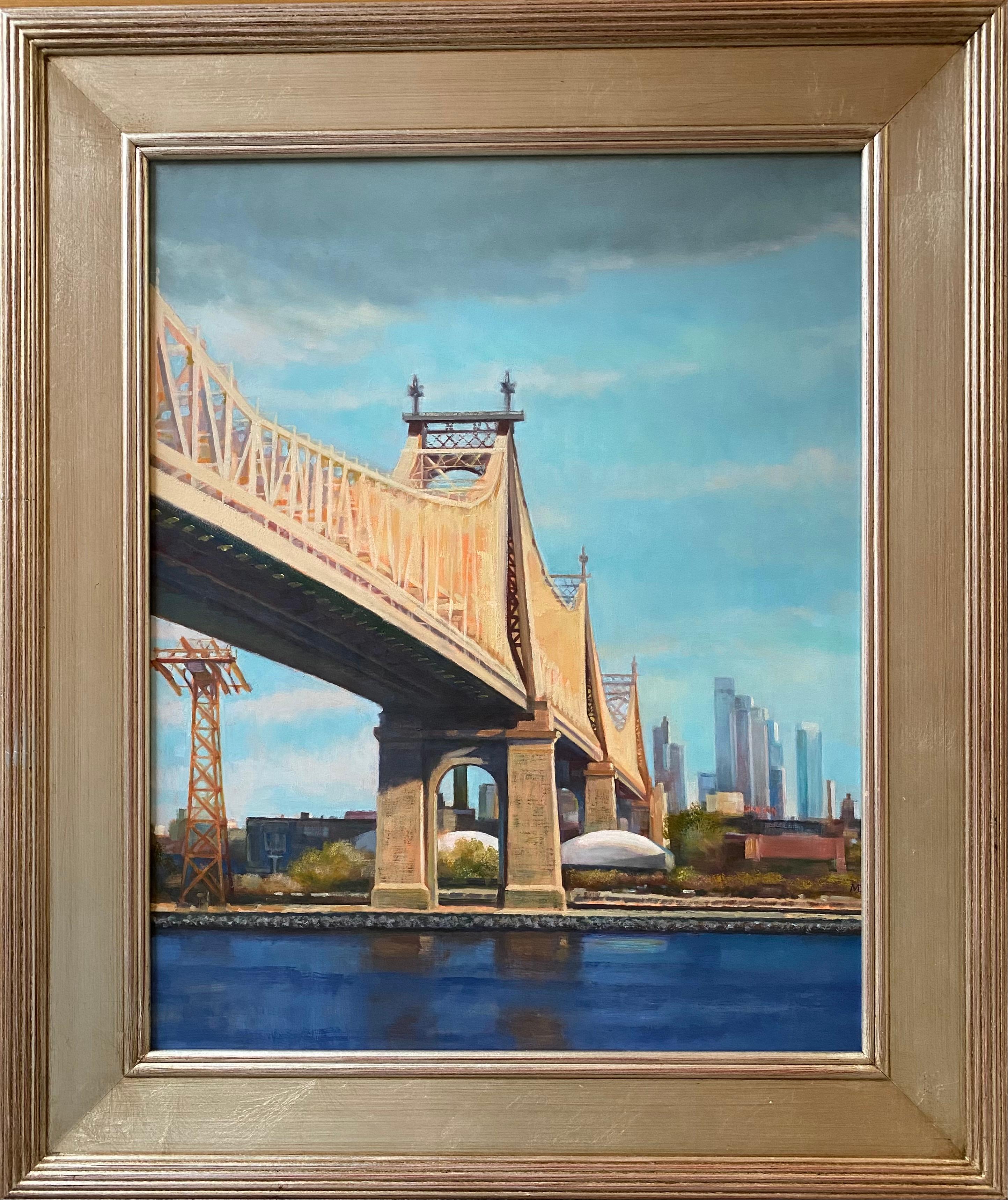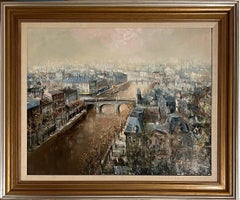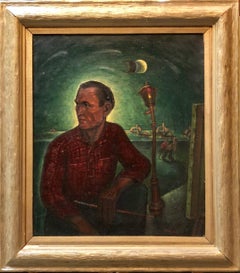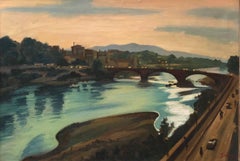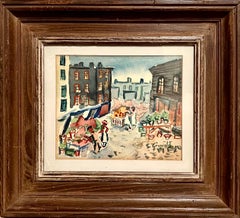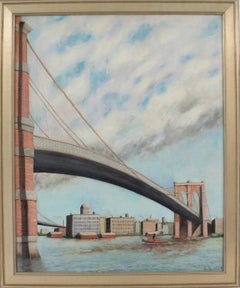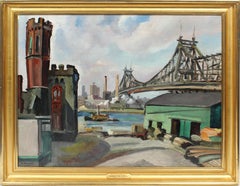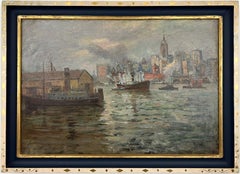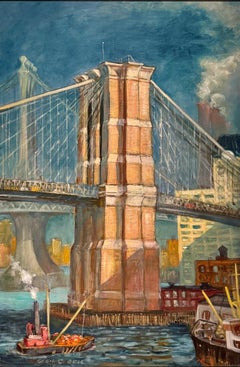Items Similar to Around East River, NYC Bridge, City Scene Oil Painting WPA Era 1940s
Want more images or videos?
Request additional images or videos from the seller
1 of 7
Maurice KishAround East River, NYC Bridge, City Scene Oil Painting WPA Era 1940s
$6,500
£4,913.19
€5,646.13
CA$9,051.21
A$10,069.10
CHF 5,278.35
MX$123,041.95
NOK 67,213.18
SEK 63,271.91
DKK 42,146.25
Shipping
Retrieving quote...The 1stDibs Promise:
Authenticity Guarantee,
Money-Back Guarantee,
24-Hour Cancellation
About the Item
Genre: Modern
Subject: Marine Landscape
Medium: Oil
Surface: Canvas
Country: United States
Dimensions w/Frame: 20.5" x 24.5"
The imagery of Maurice Kish (1895-1987), whether factories or carousels, reliably subverts expectations. His vision hovers just around the unraveling edge of things, where what is solid and clear becomes ambiguous. He is fascinated, often delighted, by the falling apart. This unexpected, fresh perspective results in oddly affecting pictures of a now long-gone New York.
Born Moishe in a town called Dvinsk, Russia (what is now Daugavpils, Latvia), Kish came with his family to New York when he was in his teens. The family settled in Brownsville, and for the rest of Kish’s life Brooklyn remained his home, though he moved from one neighborhood to another. He was close to his parents, who recognized his talent and supported his desire to become an artist.
Kish attended the National Academy of Design as well as Cooper Union. His fellow students included many other immigrants and children of immigrants who were particularly receptive to the Modernism coming from Europe. As his career progressed, Kish himself applied different strains of Modernism to different purposes. For him, the story was held above all else.
For years, Kish used the skills he acquired in art school to earn his living at a Manhattan glass factory where he painted floral designs on vases. During the Depression, Kish became a WPA painter in the Federal Art Project (FAP). FAP artists were given a mandate to create works that celebrated labor. The artists tended to be socially progressive, as Kish certainly was. Kish's work from this period, with its dark colors and rolling clouds, reveals the influence of Social Realists like Thomas Hart Benton. Apparent, too, is Kish's interest in the urban monumentality of Charles Sheeler. Kish's structures, however, lack Sheeler's almost dehumanized precision. Rather than the soulless, sleek machines of a typical modern urban dystopia, Kish's factories are shaggy old beasts as worn out as the laborers who troop through their doors. In End of Day's Toil, now at the Smithsonian, the viewer feels some affection for that rambly grandfather of a building all the tired small workers are leaving behind.
Much of Kish's work, for the FAP and elsewhere, undermines received truths in a similar way. Some early works with themes from Yiddish culture are overtly humorous: a painting of a big jolly wedding guest, looking invitingly over her shoulder; a big fiddler on a small roof. Later, the humor becomes more ironic and reflective. In another work, the rather imposing organ grinder of the late 1930s looms above a child, yet his intermediary the cockatoo is bright and appealing, and offers the girl a fortune with his beak. This could read as an allegory for capitalism as easily as a straightforward colorful street scene. A small painting of a snowy day in Washington Square gives a bird's eye view of people bent against the wind walking alone or in pairs. The huge triumphal arch at the middle of it has no connection to their movements or their lives. Kish makes its size and centrality a quiet joke about the futility of grandiose gestures. Like the buildings in his FAP works, the arch has a personality. It is a landmark that looks a bit lost.
A favorite location for Kish was Coney Island. For the laborers of the city, this was a place of great freedom and possibility. There were no bosses! Anyone could go to ride the rides and swim in the sea. For Kish, Coney Island, and especially Luna Park, became a place richly symbolic of workers’ rights. For the dreamlike paintings he set there, Kish looked past the Social Realists to the Expressionists. His colors are brilliant and his lines are wild. These images, joyfully unrestrained, give full voice to an anarchic vision merely hinted at in other works. If the structures of the earlier pictures came further out of the background than expected, these Coney Island structures completely take over the scene.
Kish made several variations on the theme of the carousel as a site of revolution. In the moonlight, the horses have broken from their poles and spin away from the calm center. The workers have come to manic life, have released themselves from the yoke of labor and have abandoned their master, the merry-go-round. They escape to different corners of the pleasure park, dance together and ride the ferris wheel. One horse pretends to be a ticket seller. It is another allegory, one that depicts a worker's holiday paradise in carnival fashion.
A painter who embraced ambiguity, Kish was himself a man who occupied many worlds simultaneously. Even during the period when he had shows at prestigious galleries and belonged to several artists' groups, he identified most strongly as an outsider, a Yiddischer. He wrote poetry in Yiddish throughout his life. In 1968, he published a volume of fifty years of these poems, Di Velt ist Mayn Lid (The World is My Song) in Yiddish, with no English translation, for his peers. Kish also translated English-language poetry into Yiddish and acted as a guide to help other Yiddish writers. Long after the art organizations ceased to provide meaning and fulfillment, Kish was a devoted member of the Yiddish Culture Association.
In addition to painting and poetry, Kish was a dancer who taught during the summers at various Jewish resorts in the Catskills. Small but lithe, he also spent some years as an amateur boxer. Well into his eighties, Kish was proud of the quality of his handball game.
By the 1940s, Kish’s career was going well, but his descriptive style of working began to fall out of fashion, supplanted by a more formal Abstraction. Kish was never able to support himself solely through his art, yet in the midst of all of his other activities, Kish continued to create his distinctive images of an immigrant's New York. He departed far from the mainstream, and in later years, seldom showed his work, preferring to keep it for himself (although he sometimes traded paintings for rent).
Of making art, Kish said, "It is a sacred mission to enrich, to elevate and to make our lives more complete." His works, though frequently playful, encourage a second look at ordinary things. His irreverence elevates by revealing flaws where his audience, all workers and outsiders of a kind, can get a purchase. Kish's art fondly celebrates the beauty of the irregular.
- Creator:Maurice Kish (1895-1987, American)
- Dimensions:Height: 20.5 in (52.07 cm)Width: 24.5 in (62.23 cm)
- Medium:
- Movement & Style:
- Period:
- Condition:frame has some wear.
- Gallery Location:Surfside, FL
- Reference Number:Seller: sku6591stDibs: LU38212012102
About the Seller
4.9
Platinum Seller
Premium sellers with a 4.7+ rating and 24-hour response times
Established in 1995
1stDibs seller since 2014
1,784 sales on 1stDibs
Typical response time: <1 hour
- ShippingRetrieving quote...Shipping from: Surfside, FL
- Return Policy
Authenticity Guarantee
In the unlikely event there’s an issue with an item’s authenticity, contact us within 1 year for a full refund. DetailsMoney-Back Guarantee
If your item is not as described, is damaged in transit, or does not arrive, contact us within 7 days for a full refund. Details24-Hour Cancellation
You have a 24-hour grace period in which to reconsider your purchase, with no questions asked.Vetted Professional Sellers
Our world-class sellers must adhere to strict standards for service and quality, maintaining the integrity of our listings.Price-Match Guarantee
If you find that a seller listed the same item for a lower price elsewhere, we’ll match it.Trusted Global Delivery
Our best-in-class carrier network provides specialized shipping options worldwide, including custom delivery.More From This Seller
View AllLarge French Oil Painting Paris, Seine River w Bridge, Landscape, Lucien Delarue
By Lucien Delarue
Located in Surfside, FL
Lucien Delarue (1925-2011)
Paris Seine River Scene.
"Seine at Paris"
Provenance: Newman Gallery, Phila. Label verso.
Hand signed on Canvas.
Dimensions: H: 25 inches: W: 31.5 inches: Frame: 35 X 41 inches
Artist Lucien Delarue was born in Paris in 1925, and he is known for his spectacular cityscape painting. Post Impressionist painter He studied at the studios of Grande Chaumiere, Paris and was a pupil of Maitre Yves Brayer. He is best know as a French Impressionist. He loved to paint the romantic streets of Paris with its stunning architecture and beauty. Also included in his repertoire is colorful French floral still life paintings, South of France country cottages, harbor views, and river scenes. At a very early age Delarue began taking part in exhibitions. Quickly he was talking medals for his works including first prize and the Vermeil-Medaille at the Salon Violet. Other gold medals include the Salon of Vincennes, and the Salon of Clichy (1973). In 1974 he won the silver medal at the Salon des Artistes Francais, and a bronze medal at the "Arts-Sciences-Lettres" exhibition in Paris. He also exhibited works at the Museum of Ile de France in the chateau of Sceaux. He held exhibitions in New York and in San Francisco in the United States. He was a member of the Salon des Artistes Francais and of the French Watercolor Society.Lucien Delarue excelled in recreating the cottages, harbor views, and expressionist architecture of Paris in his artwork. His watercolor paintings include color-rich representations of France's many scenic rivers. Delarue would eventually become a member of the French Watercolor Society and the Salon des Artistes Francais. He showed with Henk Bos...
Category
Mid-20th Century Post-Impressionist Landscape Paintings
Materials
Canvas, Oil
Paris City Scene, Portrait Oil Painting WPA Era 1940s
By Maurice Kish
Located in Surfside, FL
Genre: Modern
Subject: French Paris Scene
Medium: Oil
Surface: Canvas
Country: United States
The imagery of Maurice Kish (1895-1987), whether factories or carousels, reliably subver...
Category
Mid-20th Century Modern Landscape Paintings
Materials
Oil
Large Modernist Oil Painting Bridge over the Water Landscape
By Saul Schary
Located in Surfside, FL
Saul Schary was born in 1904 in Newark, New Jersey. Painter, Printmaker, Illustrator. He lived and worked in New York City and New Milford, Connecticut. Schary studied at the Art St...
Category
Mid-20th Century American Modern Landscape Paintings
Materials
Canvas, Oil
1940's American WPA Modernist New York City Watercolor Painting Tenement Market
By Samuel Grunvald
Located in Surfside, FL
The Market, (fauvist painting of NYC scene) 1940's.
image is 10X 11.5 inches. Hand signed lower right
Lower East Side Tenements Pushcart Market
Samuel Grunvald was a Hungarian born American WPA artist known for abstract, landscape and seascape paintings.
Arrived in the USA from Hungary in 1921 and settled in New York City where he studied at the Art Students League. Grunvald worked for the Federal Art Project, taught at Colony House in NYC. Member: Art Guild, Watercolor Society, New York Watercolor Club. exhibited at Montross Gallery, NYC, World House Galleries, NYC, Leonard Hutton Gallery, NYC, Associated American Artists Gallery and the A.C.A. Gallery. Gunvald's work spanned many modern American movements from the WPA to Abstract Expressionist painting. He was a member of the American Watercolor Society and the Brooklyn Society of Artists. He exhibited with both of these organizations and at the Brooklyn Museum of Art. He was involved the the WPA being a Federal Arts Project artist. A number of prominent Jewish artists participated in this New Deal program among them Ben Shahn, Joseph Solman, William Gropper, Philip Guston Adolph Gottlieb, Mark Rothko, Milton Avery, Ben Shahn, the Soyers (Isaac, Moses, and Raphael), and many others
Grunwald exhibited alongside other popular artists such as Paul Klee, Jean Arp, Max Ernst and Charles Burchfield. He also taught and lectured on art and easel painting, Federal Art Project, NYC. His work is included in the collections of the Museum of Modern Art and The Jewish Museum, New York. Americana.
Select Exhibitions
A.C.A. Gallery
Associated American Artists Gallery, 1936-1955
American Watercolor Society, 1932-1942
New York Watercolor Club, 1935-1937
Humanist Art...
Category
1940s Modern Figurative Drawings and Watercolors
Materials
Watercolor
1927 Oil Painting Eiffel Tower Paris American Modernist Wpa Artist Morris Kantor
By Morris Kantor
Located in Surfside, FL
Morris Kantor New York (1896 - 1974)
Paris from the Ile St. Louis, 1927 (view of Eiffel Tower)
Oil painting on canvas
Hand Signed lower left.
Provenance: Hirshhorn Museum and Scul...
Category
1920s American Modern Landscape Paintings
Materials
Canvas, Oil
Quai De La Tournelle, Paris Street Scene Oil Painting, American Deaf Modernist
By Robert Freiman
Located in Surfside, FL
Paris street scene oil painting in original vintage hand carved frame, showing some wear. Signed l.r. and dated 1953. Inscribed on reverse with title.
28.50 in. by 33.50 in. include frame. Unframed 19.75 in. by 24 in.
Robert Freiman, deaf from birth, was born in March 1917 in New York City. He attended an oral program near his home and later transferred to the Lexington School for the Deaf when he was six. Early in his childhood, his love for drawing, painting and studying became apparent, and as an adult, he continued his studies in New York at the National Academy of Design, Pratt Institute, the Art Students League and the Parsons School of Design. In Paris, France he studied at the Ecole des Beaux Arts. Bob Freiman was especially focused on painting portraits and figures in motion in various mediums, especially the mixed-media combination of watercolor, acrylic and pen. Among his subjects were acrobats, ballet dancers, cyclists and other athletes. He as well focused on abstracts for a time, discovering new media in his works with quick brushwork and expressive movements.
In the latter part of his career, his style became abstract and surreal with images of metaphysical landscapes with architectural elements such as arches, towers, pyramids and castles floating in the air. The famed art critic Pierre Rouve wrote: “It is therefore refreshing to see them revitalized by the colourist wealth and virile handwriting of Robert Freiman, probably the best American water-colorist since John Marin. He worked in Provincetown and Nantucket and regularly exhibited there. He showed at Doll & Richards gallery of Boston alongside John Chetcuti, Lloyd Goodrich, Tod Lindenmuth, William Meyerowitz, Dwight Shepler, Elizabeth O'Neill Verner, Stanley Woodward, Andrew Wyeth, and others. His work bears the influence of the mid century school of Paris in particular Jean Carzou. He was a regular exhibitor at the Sidewalk Art...
Category
Mid-20th Century Expressionist Landscape Paintings
Materials
Oil
You May Also Like
Brooklyn Transfer East River Crossing, Oil on Canvas Painting Frederick Reimers
Located in Atlanta, GA
"Bklyn Transfer, East River Crossing" by Frederick Reimers (1911–1994)
This unique, captivating cityscape painting by Frederick Reimers (USA, 1911–1994) offers a dynamic view of the ...
Category
20th Century Modern Landscape Paintings
Materials
Canvas, Oil, Acrylic
Antique American Modernist Cityscape Ashcan School 59th Street Bridge Painting
By Robert Hallowell
Located in Buffalo, NY
Antique American ashcan school New York City oil painting by Robert Hallowell (1886 - 1939). Oil on board, circa 1929. Signed. Displayed in a period giltwood frame. Image, 30"L x 25"H.
Category
1920s Modern Landscape Paintings
Materials
Canvas, Oil
Brooklyn Bridge through the Clouds-Original New York 20th Century Oil Painting
By Max Kuehne
Located in Marco Island, FL
An atmospheric and impressionistic view of New York City's towering skyline with ships in the harbour on a misty day. This lovely painting is housed in a beautifully detailed artist...
Category
Early 20th Century American Impressionist Landscape Paintings
Materials
Canvas, Oil
Brooklyn Bridge NYC American Scene Social Realism Mid 20th Century Modern WPA
By Cecil Crosley Bell
Located in New York, NY
Brooklyn Bridge NYC American Scene Social Realism Mid 20th Century Modern WPA
Cecil C. Bell (American, 1906-1970)
Brookyn Bridge amid the NYC Waterfront
35 ½ x 23 ½ inches
Oil on Bo...
Category
1930s American Realist Landscape Paintings
Materials
Oil, Board
Morning on East River New York City Impressionist Bridge Boat Scene Oil Painting
By Christopher Willett
Located in Philadelphia, PA
Impressionist New York City a wonderful morning on the East River. Tug boats gently make their way up the river with a backdrop of the Brooklyn Bridge. Birds flying in the crisp morn...
Category
Late 20th Century American Classical Paintings
Materials
Canvas, Paint
59th Street Bridge, original realist New York City landscape
By Michael Davis
Located in Spring Lake, NJ
A veritable life line for New York City that connects the boroughs of Manhattan to Queens, NYC artist Michael Davis painted this original landscape in a realist style to ensure capturing the might and splendor that such an architectural and engineering achievement represents to civilization and certainly to New York. A colorist, Davis seeks simplicity of expression, with clean lines paired with love of his subject matter balanced with aquamarine skies and sapphire blue water. His addition of sky scrapers in the background adds scale and dimension. Davis earned his BFA from Pratt Institute of NYC where he is a life member of the famed Art Students League. Davis' work has shown in the Grand Central Gallery, the National Academy of Design, the Salmagundi Club and the National Arts Club among others. This original oil painting is shown in a champagne silver plein air frame...
Category
21st Century and Contemporary Realist Landscape Paintings
Materials
Oil
More Ways To Browse
For Rent
Mid Century City Scene Oil Painting
Brooklyn Bridge Painting
Vintage 1940s Paint Colors
Artist Painting Landscape Wpa
Vintage Spin Art
Vintage Manhattan Glass
Catskills Painting
Wpa Styled Oil Paintings
Vintage Machine Oiler
Girl Horse Painting
English River Scene Painting
Oil Paintings Of Jewish Man
Dark Floral Oil Painting
Painting Girl With Bird
Moonlight Scene
Wpa Era Paintings
Maurice Eyer
